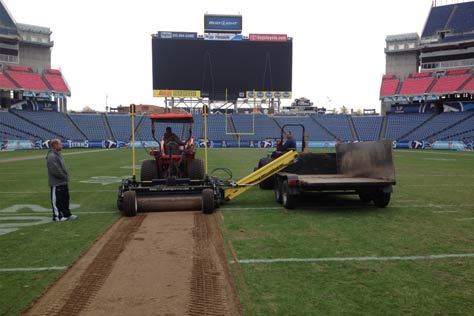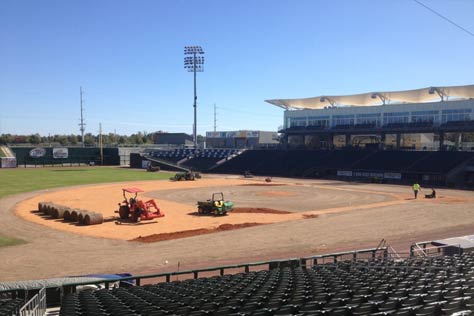Turfplaning
Laser turfplaning is the precision removal of surface irregularities (up to 2") from turf areas in a single pass. Through the use of a g2 turftools, inc. 84" turfplaner equipped with proportional laser, leveling to an accuracy, never before attainable, of +/− ¼" on existing turf areas (athletic fields, golf tees, golf fairways) is now reality. This revolutionary turfplaning process does not require the need to remove or replace the turfgrass on effected areas. Turfplaning not only reduces cost of resurfacing to a fraction of conventional turf removal, tilling, re-grading, and re-grassing, but also greatly reduces time and need to re-grow root zone prior to using. With the use of turfplaning, full recover of turf and resumption of normal activities on a smooth and consistent surface can be accomplished in as little as 3 to 6 weeks.
Cost
Conventional surface renovation requires the removal of existing turf, tilling of the soil profile, rolling, laser grading of the existing soil profile, removing excess soil removal, re-grassing (seeding,sprigging or sodding) and finally growing in the new turf. Turfplaning only requires a single pass to remove the top layer of existing turf and soil, without disturbing the underlying roots or soil profile. At approximately ¼ the cost of conventional renovation, turfplaning is the best alternative.

Accurate
Conventional surface renovation requires that the existing soil profile be disturbed and recompacted prior to laser grading (maximum accuracy +- ¼”). This can lead to potentially inconsistent compaction that can result in settling and a surface that goes “off-grade” much faster. With dual proportional laser control and a laser accuracy to +- 1/16” you can expect your turfplaned finished grade to be +- ¼” and stay there since the underlying soil profile is undisturbed.
Faster
Conventional surface renovation can take up to 4 weeks or more, depending on weather and turf availability. Turfplaning with production rates exceeding 4,000 sf per hour, an average football field can be put back on grade in 2-3 days.
Grow-in
Because turfplaning leaves the underlying roots intact, the average field is completely grown in after 3-4 weeks. This keeps much of the plants structure and stability in place.

Water Conservation
The water requirements of a normal “grow-in” can easily exceed ½” per day (depending on weather conditions). Turfplaning only requires normal watering or 1-2” per week.
Layering
Soil layering has always been a problem with sodding. No matter how good your soil profile is, unless you sod is grown on the same type of soil profile, your soil profile is compromised as soon as your sod is laid. A vigorous aerification program must follow to restore the original soil profile. Turfplaning removes all of the excess material (thatch and soil) and returns the surface back to the original soil profile without contamination.
STS has financing available for many of the services that we provide. If you are in need of our services, but just can’t get the funds together, please ask about the different financing options available.





